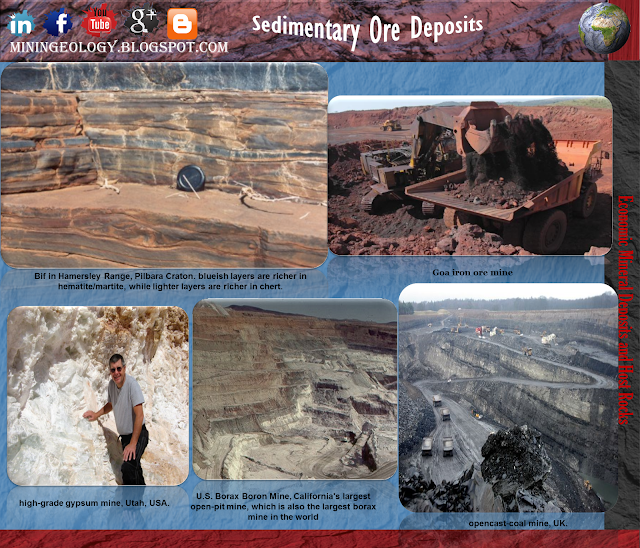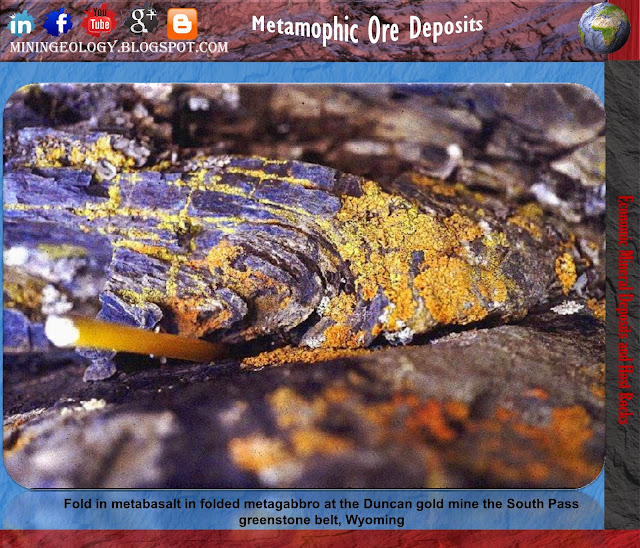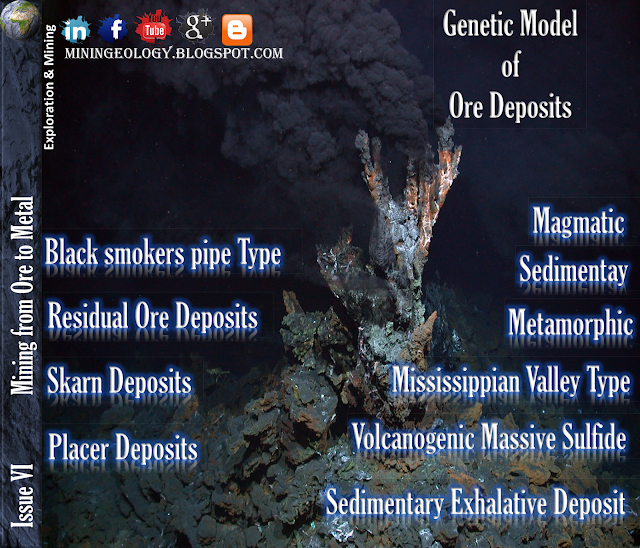<div dir="ltr" style="text-align: left;" trbidi="on">Magmatic
Or “Mafic Igneous Intrusion Associated Deposits”
Syngenetic : The Ores are formed after their host rocks.
Primary : Nickle.
Secondary : Chromite, Copper, Molybdenum, (PEG).
Host: The most significant magmatic deposits are related to mafic (gabbro, norite) and ultramafic (peridotite, dunite) rocks originated from the crystallization of basaltic and ultramafic magma.
Process : Magmatic intrusions result in partitioning of elements and contamination of the melt by assimilation of the host rock. Gravitation segregation of Sulphur result in sulfide ore to form at the bottom of the melt. It is also possible to produce this type of ore through the meteorite impacts, rift/continental flood basalt-associated sills and dykes, volcanic flows and troctolite intrusions.
Examples : There are several largest magmatic deposits: they are Cr-PGE deposits at Bushveld Igneous Complex, South Africa, Ni-Cu-PGE deposits at The Great Dykes, Zimbabwe, Ni-PGE-Cr deposits at Sudbury “(meteorite impact-unusual), Canada, Ni-Cu-PGE deposits at Stillwater Igneous Complex, Montana, US.
 Magmatic Ore Deposits
Magmatic Ore Deposits
Similarly economic limestone deposits are formed by chemical sedimentation of calcium magnesium carbonate on the seafloor. Coal and lignite are formed under sedimentary depositional condition. Evaporite deposits form through the evaporation of saline water in lakes and sea, in regions of low rainfall and high temperature. The common evaporite deposits are salts (halite and sylvite), gypsum, borax and nitrates. The original character of most evaporite deposits is destroyed by replacement through circulating fluids.
For More >>> Here
 Sedimentary Ore DepositsMetamorphic
Sedimentary Ore DepositsMetamorphic
Metamorphic deposits are formed in different types of metamorphic conditions, ranging from low to high temperature and low to high pressure, due to regional prograde or retrograde metamorphic process and hosted by metamorphic rocks. Minerals like garnet, kyanite, sillimanite, wollastonite, graphite and andalusite are end product of metamorphic process. Three general types of metamorphic deposits are known: 1) copper-rich, 2) gold-rich, and 3) lead-zinc-silver-rich.
1- Copper-Rich Types: These metamorphic deposits are characteristically associated with very low grade to low grade metamorphism. Most often they form in terrains where mafic or ultramafic basement rocks are overlain upsection by organic-rich sedimentary rocks. Examples Kennicott, Alaska, Ore = Chalcocite + Bornite. White Pine, Michigan, Ore = chalcocite + bornite + chalcopyrite + minor sphalerite.
2- Gold-Rich Types: are of two general types: 1) Archean iron formation types, and 2) quartz-carbonate veins. Archean Iron Formation Types: Occur mostly in Precambrian shield areas. Vein morphology but most veins apparently concentrated in peculiar iron-rich shales and sandstones which are upgraded by at least one and usually several metamorphic events. Gold occurs in quartz veins in the silicate or sulfide facies host rocks. Examples Precambrian of Wyoming Jardine, Montana.
Quartz-Carbonate Types:
Often associated with greenstone belts in shield areas. Ore formed in structural zones/shear zones which are regional in scale. The districts usually contain large scale folding as well. Examples Valdez Creek District, Alaska Conn Mine, Eastern Canada AJ Mine, southeast Alaska.
3- Lead-Silver-Rich: deposits typically contain
galena, sphalerite, and locally tetrahedrite and
chalcopyrite as ore minerals.
Examples Coer de Lane district, Idaho.
For More >>> Here
 Metamorphic Ore Deposits
Metamorphic Ore Deposits
Examples:
<div style="margin-bottom: .0001pt; margin: 0in; text-align: justify;">Kidd Creek, Timmins, Canada<b><span style="color: white; font-family: Philosopher; font-size: 14.0pt; mso-bidi-font-family: Andalus; mso-fareast-font-family: "Times New Roman"; mso-fareast-theme-font: minor-fareast; mso-font-kerning: 12.0pt; mso-themecolor: background1;">, is the largest VMS deposit (35 Mt @ 2.2% Cu, 5.3% Zn, 0.22% Pb and 60 g/t At at 2005) in the world. Kidd is also the deepest (
أكثر...
Or “Mafic Igneous Intrusion Associated Deposits”
Syngenetic : The Ores are formed after their host rocks.
Primary : Nickle.
Secondary : Chromite, Copper, Molybdenum, (PEG).
Host: The most significant magmatic deposits are related to mafic (gabbro, norite) and ultramafic (peridotite, dunite) rocks originated from the crystallization of basaltic and ultramafic magma.
Process : Magmatic intrusions result in partitioning of elements and contamination of the melt by assimilation of the host rock. Gravitation segregation of Sulphur result in sulfide ore to form at the bottom of the melt. It is also possible to produce this type of ore through the meteorite impacts, rift/continental flood basalt-associated sills and dykes, volcanic flows and troctolite intrusions.
Examples : There are several largest magmatic deposits: they are Cr-PGE deposits at Bushveld Igneous Complex, South Africa, Ni-Cu-PGE deposits at The Great Dykes, Zimbabwe, Ni-PGE-Cr deposits at Sudbury “(meteorite impact-unusual), Canada, Ni-Cu-PGE deposits at Stillwater Igneous Complex, Montana, US.
 Magmatic Ore Deposits
Magmatic Ore DepositsSedimentay
The sedimentary deposits are concordantand may be integral part of stratigraphic sequence. It is formed due to seasonal concentration of heavy mineralslike hematite on the seafloor. The structures consist of repeated thin layers of iron oxides, hematite or magnetite, alternating with bands of iron-poor shale and chert. The examples are Pilbara BIF, Northwestern Australia, Bailadila and Goa iron ore, India. Similarly economic limestone deposits are formed by chemical sedimentation of calcium magnesium carbonate on the seafloor. Coal and lignite are formed under sedimentary depositional condition. Evaporite deposits form through the evaporation of saline water in lakes and sea, in regions of low rainfall and high temperature. The common evaporite deposits are salts (halite and sylvite), gypsum, borax and nitrates. The original character of most evaporite deposits is destroyed by replacement through circulating fluids.
For More >>> Here
 Sedimentary Ore DepositsMetamorphic
Sedimentary Ore DepositsMetamorphicMetamorphic deposits are formed in different types of metamorphic conditions, ranging from low to high temperature and low to high pressure, due to regional prograde or retrograde metamorphic process and hosted by metamorphic rocks. Minerals like garnet, kyanite, sillimanite, wollastonite, graphite and andalusite are end product of metamorphic process. Three general types of metamorphic deposits are known: 1) copper-rich, 2) gold-rich, and 3) lead-zinc-silver-rich.
1- Copper-Rich Types: These metamorphic deposits are characteristically associated with very low grade to low grade metamorphism. Most often they form in terrains where mafic or ultramafic basement rocks are overlain upsection by organic-rich sedimentary rocks. Examples Kennicott, Alaska, Ore = Chalcocite + Bornite. White Pine, Michigan, Ore = chalcocite + bornite + chalcopyrite + minor sphalerite.
2- Gold-Rich Types: are of two general types: 1) Archean iron formation types, and 2) quartz-carbonate veins. Archean Iron Formation Types: Occur mostly in Precambrian shield areas. Vein morphology but most veins apparently concentrated in peculiar iron-rich shales and sandstones which are upgraded by at least one and usually several metamorphic events. Gold occurs in quartz veins in the silicate or sulfide facies host rocks. Examples Precambrian of Wyoming Jardine, Montana.
Quartz-Carbonate Types:
Often associated with greenstone belts in shield areas. Ore formed in structural zones/shear zones which are regional in scale. The districts usually contain large scale folding as well. Examples Valdez Creek District, Alaska Conn Mine, Eastern Canada AJ Mine, southeast Alaska.
3- Lead-Silver-Rich: deposits typically contain
galena, sphalerite, and locally tetrahedrite and
chalcopyrite as ore minerals.
Examples Coer de Lane district, Idaho.
For More >>> Here
 Metamorphic Ore Deposits
Metamorphic Ore DepositsVolcanogenic Massive Sulfide
VMS and VHMS type of ore deposits contribute significant source of Cu-Zn-Pb sulfide +- Au, Ag, formed as a result of volcanic associated hydrothermal events under submarine environments at or near the seafloor. It forms in close time and space association between submarine volcanism, hydrothermal circulation and exhalation of sulfides, independent of sedimentary process. The deposits are predominantly stratabound (volcanic derived or volcano-sedimentary rocks) and often stratiform in nature. The ore formation system is synonymous to black smoker type of deposit. Examples:
<div style="margin-bottom: .0001pt; margin: 0in; text-align: justify;">Kidd Creek, Timmins, Canada<b><span style="color: white; font-family: Philosopher; font-size: 14.0pt; mso-bidi-font-family: Andalus; mso-fareast-font-family: "Times New Roman"; mso-fareast-theme-font: minor-fareast; mso-font-kerning: 12.0pt; mso-themecolor: background1;">, is the largest VMS deposit (35 Mt @ 2.2% Cu, 5.3% Zn, 0.22% Pb and 60 g/t At at 2005) in the world. Kidd is also the deepest (
أكثر...

